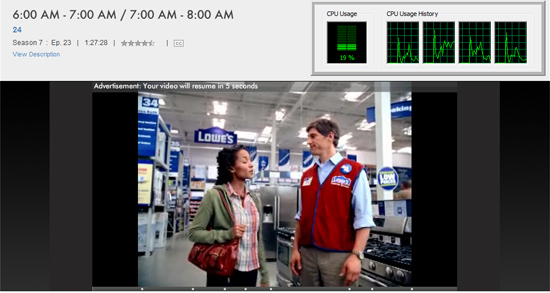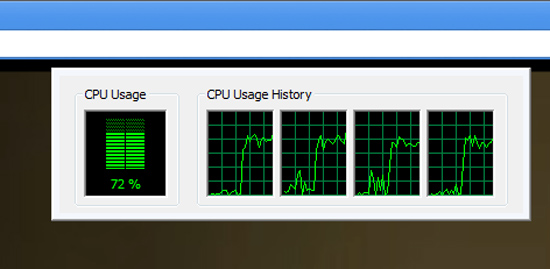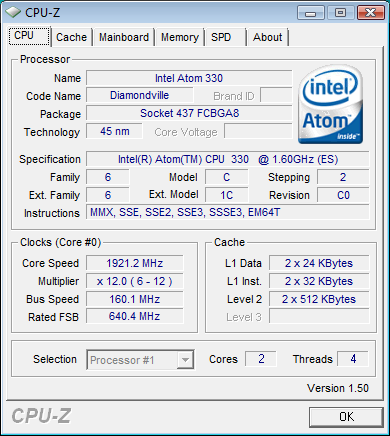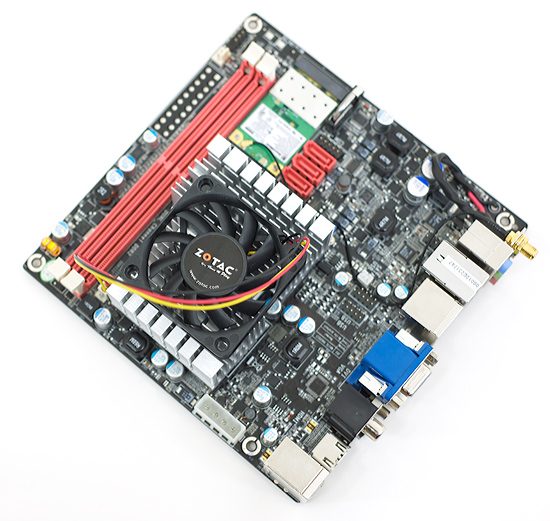Oooh, people like it. I must admit that Zotac did an excellent job on the world’s first mini-ITX Atom/Ion motherboard. The product is interesting enough to warrant a follow-up, answering some of your questions that I didn’t address in the original review.
Wake on USB: Flaky at Best
The first question you all asked was whether or not the Zotac Ion board properly supports Wake on USB. When the Zotac board goes into a sleep state can it be “woken up” by hitting a key on a USB keyboard, moving a USB mouse or even using a media center remote control?

Unfortunately the answer appears to be: no, at least not reliably.
I configured Windows Vista to put the system to sleep after one minute and then tried to wake it up. With a Dell USB keyboard and Logitech G5 USB mouse hooked directly up to the Zotac board, neither could pull the machine out of its sleep state. However, if I use the keyboard and mouse through my iogear KVM then the mouse will wake the machine up. The keyboard won’t wake it up at all. Your best bet is to tell the machine to never go to sleep. Drawing less than 25W at idle, it’s not the worst thing in the world, but I’d still rather Zotac made it work properly.
I contacted Zotac about the issue but have yet to hear a response. It turns out that the same problem exists on Zotac’s LGA-775 GeForce 9300 board so I don’t have high hopes for a quick fix at this point. I’ll keep pushing from my end to see if we can get somewhere with it.
Zotac Ion: 720p Gaming Performance
In my Zotac Ion review I only included one gaming result: 17.7 fps in World of Warcraft at 800 x 600 with WoW’s Good Quality settings. A few of you asked for more details on how well the Ion could play games; I happily obliged and ran the board with a few more games and settings. The table below shows the frame rates I was able to achieve:
| Zotac Ion-A (Atom 330) 720p Performance | |
| Left 4 Dead (Medium Quality) | 25.0 fps |
| Far Cry 2 (Medium Quality) | 9.0 fps |
| Far Cry 2 (Low Quality) | 12.0 fps |
| Fallout 3 (Medium Quality) | 17.3 fps |
| Fallout 3 (Low Quality) | 21.0 fps |
| Red Alert 3 (Medium Quality) | 18.0 fps |
Far Cry 2, even at its lowest quality settings, can only manage 12 fps at 720p; but that’s a stressful game. Left 4 Dead, at a balance of low/medium quality settings managed 25 fps. Fallout 3 straddled the borderline of playability when set to Low quality defaults at 21 fps.
I even tried Red Alert 3, where I managed 18 fps at Medium quality.
It’s possible to get near playable frame rates with the Zotac Ion at 720p but it’s definitely not smooth unless you’re playing something truly light on the CPU/GPU.
Watching Flash Video on the Ion
You should never have to worry about your system specs when it comes to watching Flash video. Sites like YouTube and Hulu exist simply because of the large number of PCs that can play Flash video. Can the dual-core Atom 330 in the Zotac Ion-A handle watching video online?
To test this I watched the season finale of 24 on Hulu. I performed three tests: I watched the season finale in its default window at low res, high res (480p) and then full screen.
Thankfully, Adobe’s Flash player appears to be well threaded - all four cores (two physical, two virtual) had parts of the playback task running on them. The first test proved to work just fine:

CPU utilization never hit above 27% and for the most part stayed around 19%.
Next I tried Hulu’s high-res option, which keeps the playback window the same size but increases the resolution to 480p. While CPU utilization jumped to nearly 40%, playback was still smooth. Note that high-res Hulu isn’t smooth on a single-core Atom, the 330 is necessary for a good Hulu experience.

Note that I tested under Google Chrome, however if you use Internet Explorer your CPU utilization will drop a bit.
The experience you get when going full screen in Hulu is very dependent on your desktop resolution. With a 1920 x 1200 desktop resolution, 480p Hulu is unwatchable on the Zotac Ion. CPU utilization maxed out just under 80% and video playback was choppy.

Dropping the desktop resolution to 1280 x 720 made things more bearable, with CPU utilization generally under 50% but it still wasn’t totally smooth. I’m not sure how much of this is Adobe’s fault and how much is the Atom just not being able to keep up, but full screen Flash video playback just isn’t in the cards.
Zotac provides a couple of performance tweaking options within its BIOS. You can set memory latencies manually as well as adjust the FSB and memory clocks. The biggest failure here is the inability to adjust the Atom’s core voltage, which is ultimately what limits how far we can push the processor.

The Atom 330 runs at 1.6GHz by default with a 12.0x multiplier and a 533MHz quad-pumped FSB frequency (133MHz source clock x 4). Bumping the FSB up to 667MHz gave me a 2.0GHz clock frequency and I was actually able to boot into Windows at that speed. Unfortunately, even with additional cooling, that wasn’t stable enough to complete my benchmarks. I suspect that with additional voltage I’d be able to get 2.0GHz stable.

I backed down to a 640MHz FSB, resulting in a 1.92GHz CPU frequency and the result was completely stable over the course of several hours of benchmarking. Performance also went up by a good amount:
| x264 HD Encode (1st Pass) | World of Warcraft Frame Rate | Power Consumption | |
| Atom 330 @ 1.92GHz | 14.5 fps | 20.5 fps | 28.5W |
| Atom 330 @ 1.60GHz | 12.2 fps | 17.7 fps | 28.2W |
I generally saw a 15 - 19% increase in performance over the stock 1.60GHz Atom 330, which is quite good given that it’s a 20% increase in CPU frequency. I kept memory clock stationary at 800MHz but I’m guessing there’s additional room for a performance boost if you overclock that as well.
Power consumption only went up 0.3W from 28.2W to 28.5W - even overclocked, the Atom is a very efficient microprocessor.
Cooling the Zotac Ion
I made it a point to talk about the fanless design of the Zotac Ion in my original review. For most of my tests I had a fan connected (just so I could tell when my otherwise silent machine was on), but I did test the system without a fan connected.

On a table with no active airflow over the heatsink, the latest version of CoreTemp showed temperatures in the 80 - 97C range - which are extremely high. Earlier versions of CoreTemp showed the CPU temperature at 60 - 70C, so it’s possible that neither value is correct. One of my first experiences with the Atom processor was it running Unreal Tournament 2004 without a heatsink or fan, I could actually touch the CPU core itself and it wasn’t hot at all. I’m guessing that the majority of thermal output here is from the GeForce 9300 or Ion chipset. Keep in mind that Intel’s own Atom mini-ITX boards have an extremely tiny heatsink on the CPU.
Without a fan the Zotac heatsink does get hot, but I haven’t had the machine crash on me without a fan running. I’m guessing that in a case with a single, slow spinning fan you should be fine. Given that a single hard drive can put out nearly as much heat as the Atom CPU, if you don’t have a solid state drive in your machine I might suggest mounting the optional fan.
With the fan running I saw temperatures below 30C as reported by CoreTemp and the heatsink was cool to the touch.
NVIDIA’s own ESA utility was not able to tell me the temperature of the GPU, but I’m fairly certain that’s where the heat is coming from. Since it shares a heatsink with the CPU, that’s most likely what’s responsible for the very high core temperatures.
Blu-ray and Gaming Power Consumption
In order to produce comparable numbers to previous CPU articles I ran the same power test in my Zotac review as I did in other CPU reviews. While the x264 encode test is good for stressing the CPU, it doesn’t do anything to the GPU. So what does power consumption look like when you’re pushing the GPU? Interestingly enough: not very different:
Playing back a Blu-ray movie using the 9300’s PureVideo engine actually uses less power than when the GPU is idle and the CPU is running at 100%. Remember that NVIDIA’s PureVideo decode engine is separate from the 3D rendering engine, it’s a highly specialized piece of the die useful only for video decode. As a result, it’s highly power efficient.
| Idle Power | x264 Encoding Power Consumption | Blu-ray Playback Power Consumption | World of Warcraft Power Consumption | |
| Zotac Ion-A | 25W | 28.2W | 28.0W | 34.0W |
The story is very different when you look at total system power consumption while playing World of Warcraft. We see our highest power consumption in this scenario since both the CPU and the SPs on the GPU are working in parallel.
While my Blu-ray CPU utilization numbers were taken without a BD drive attached, it’s worth noting that simply connecting an optical drive to the system can significantly increase power consumption. With my Sony Blu-ray drive plugged in to Zotac’s Ion board the system’s idle power consumption went up from 25W to 29W - that’s a 16% increase.
I would provide load power measurements with a Blu-ray drive attached but PowerDVD 9 started to complain about an incompatible graphics driver and refused to play any encrypted Blu-ray content. Note that this was the same install I ran my original Blu-ray playback tests on, simply several reboots and a couple of game installs later. Unfortunately it continues to be more user friendly to circumvent Blu-ray disc encryption to watch movies you own than to simply insert the disc and watch them on the PC. What would we do without AnyDVD HD.
Final Words
Availability of the Zotac Ion A boards (with the dual-core Atom 330) is still pretty limited (Newegg only has the single-core version in stock) but I still stand by it being a good little motherboard. I personally wouldn’t touch the single-core version unless it was just being used for a file server or something similarly light on the CPU, in which case it might make sense to snag the cheaper Intel version.
For now the Ion looks like a good platform, although I do wonder what will come of it next year. Intel isn’t very happy about NVIDIA’s Apple coup and the recent attention of Ion. If Intel doesn’t enable seamless HD video playback with Pineview then NVIDIA deserves to see Ion grow into a success. Oh and Intel, if you’re listening, 8-channel LPCM audio over HDMI would be a nice plus (I’ll be extra happy if we get bitstreaming of HD audio codecs).



great review! I am supposed to receive mine a few days and i really look forward playing hd content.
ReplyDeletei wonder if its possible to replace the included wifi module by a gforce gtx pci-e card